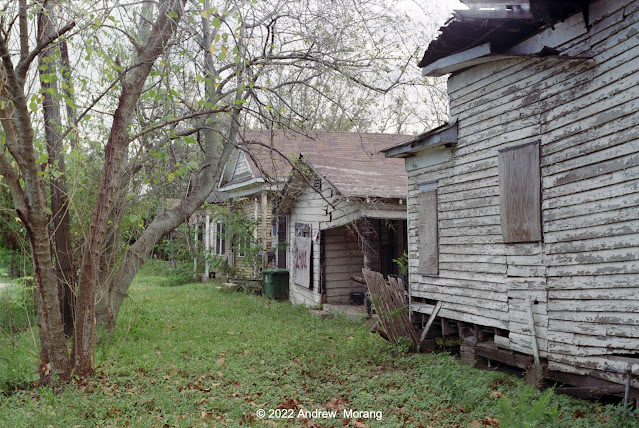This is the third of my irregular series on Houston and south Texas.
The Wards were political subdivisions of the City ofHouston. The City officially abolished the Wards in 1915, but the terms remain to describe the approximate geographic districts of the city. People still say that they live or work in one of the wards.
Fifth Ward
The 5th ward was north and east of the city. It was formerly a working class district with laborers from the shipyards and the Houston Ship Canal.
I had been photographing downtown and wandered into the 5th Ward sort of by accident. All of a sudden, I was in West Jackson again. I saw block after block of little wood shotgun shacks, some painted but many dirty, piles of trash, boxes, filth, and bedsteads on the curb, rows of grim brick subsidized housing, gutters/troughs full of ponded water, dangling wires, abandoned strip malls and corner stores with trash on the pavement, and some houses with big fences and "No Trespassing" emblazoned on big signs. The dudes were washing their bling cars with the protruding cones sticking out of the wheel hubs. How is this possible? Are we cursed forever with this economic/social blight, even in rich American cities?
 |
| View of Houston business district to the southwest |
 |
| West Street cottage near Tower 26 railroad junction |
 |
| Brooks Street cottages |
Several streets near the Tower 26 railroad junction had many abandoned houses. The backs faced the tracks. Maybe train traffic made them too noisy or dangerous.
 |
| 2023 Semmes Street, former school but used by a recycling company (probably defunct) |
 |
| Restored shotgun houses, 2208 Semmes Street |
Third Ward
Third Ward is southeast of downtown within the 610 loop. It is east of the Texas Medical Center and easily accessibly by bicycle on the Brays Bayou Greenway Trail. According to Wikipedia, "The ward became the center of Houston's African-American community. Third Ward is nicknamed "The Tre""
 |
| Homan Street near the Columbia Tap Rail Trail |
 |
| Church of the Living God, 2509 Burkett Street |
 |
| Cormorant mural, Delano Street |
As you can see, Houston is full of interesting subject matter. Stand by for more examples.
I took these photographs on Kodak Gold 200 film using my early-1950s Kodak Retina IIa camera with its 50mm ƒ/2 Xenon lens. The Gold 200 is rather grainy and I may not use it again. I miss the gorgeous Gold 100 from the early 2000s. The Retina has an accurate shutter and excellent coated lens; I have no issues with its optical quality. But I am having some trouble framing correctly through the rather squinty viewfinder. And the camera is a bit fiddly for my clumsy hands.









































